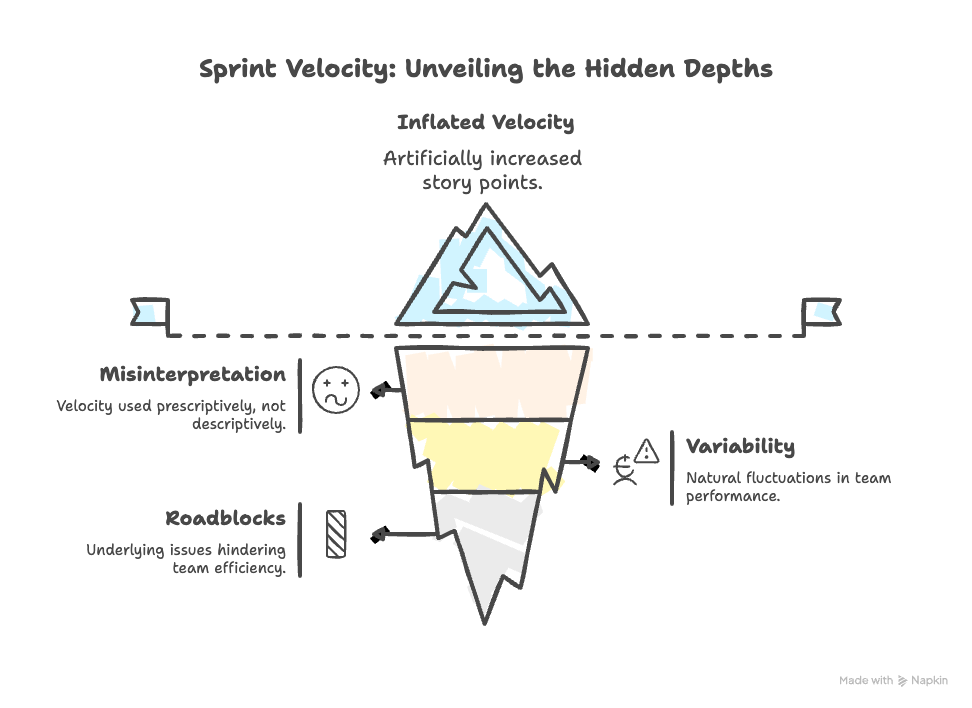What Is Sprint Velocity? All You Need to Know about it

Every engineering leader faces the same fundamental question: How do we measure success?
Your team is busy. They're writing code, reviewing pull requests, running tests, and shipping software. That’s all great. But for leaders focused on continuous improvement, the questions remain: Were we successful this sprint? Could we have done better? How does this release compare to the last one?
Agile teams often turn to sprint velocity to answer these questions. It's a popular metric, but it's also one of the most misunderstood and misused. Let's break down what it is, what it isn't, and how to use it effectively.
Sprint Velocity: What Is It?
First, a quick refresher on sprints. Software teams work in fixed-length development cycles—usually one or two weeks—called sprints. Before a sprint begins, the team commits to a specific list of tasks from their backlog.
To figure out how much work they can commit to, teams estimate the complexity of each task. There are a few common ways to do this:
- Story Points: Abstract numbers that represent the relative complexity of one task compared to others.
- Hours: A direct estimate of the time required.
- T-Shirt Sizing: A more general method using sizes like S, M, L, XL to estimate effort.
No matter which estimation method you use, the calculation is simple:
Sprint velocity is the average amount of work (measured in story points, hours, etc.) a team completes during a single sprint.
If your team completed 30 story points in the first sprint, 35 in the second, and 32 in the third, your average velocity would be (30+35+32)/3=32.3 story points per sprint. This number then becomes a baseline for forecasting how much work the team can take on in future sprints.

Key Things to Know About Sprint Velocity
If you're starting to use velocity to measure your team's performance, there are a few critical truths you need to understand to avoid falling into common traps.
1. Velocity Is Descriptive, Not Prescriptive
This is the single most important thing I wish more leaders understood. Velocity describes what a team has done in the past; it doesn't prescribe what they should do.
Think of it like measuring the average rainfall in your city. You can use historical data to predict future rainfall, but you can't stand outside and demand that it rain 3 inches today. Telling a team, "Our goal is to increase velocity by 20% this quarter," is just as ineffective. It pressures them to focus on the number, not the work.
Instead of prescribing a velocity target, use it as a diagnostic tool. A sudden drop in velocity isn't a failure; it's a signal. It tells you to dig deeper. This is where a holistic view becomes crucial. At EvolveDev.io, we integrate data from tools like Jira and GitHub to give you the full context. You can see if a drop in velocity correlates with a spike in bug fixes or an increase in code review time, helping you understand the why behind the number.
2. Velocity Is Variable
Your team is made up of people, not robots. People have good weeks and bad weeks. They get sick, take well-deserved vacations, and sometimes get pulled into unplanned fire drills. 🔥
For this reason, a team's velocity will naturally fluctuate from sprint to sprint. Fixating on the velocity of a single sprint is like judging your entire cross-country road trip based on one hour stuck in traffic. It’s not a useful data point on its own.
The real value comes from looking at the trend over multiple sprints. Is the average velocity generally stable, trending up, or trending down? This longer-term view smooths out the inevitable bumps and gives you a much more accurate picture of team capacity and predictability.
3. Increasing Velocity Is Difficult and Counterintuitive
When managers see a metric, the first instinct is often to try and make the number go up. "We need more features, faster! Let's increase velocity!"
In my 20+ years of experience, this approach almost always backfires. The team's focus shifts from shipping quality software to figuring out how to game the velocity metric. Meetings about "why we aren't faster" replace actual coding time.
Counterintuitively, the best way to improve a team's output is to stop talking about velocity. Instead, focus on removing roadblocks.
- Are code reviews taking too long?
- Is the team drowning in technical debt?
- Are engineers spending more time in meetings than in their IDE?
When you solve these underlying problems, velocity improves as a natural byproduct of a healthier, more efficient process. This is the core of engineering excellence. Tools that provide visibility into the entire development lifecycle—from PRs to deployments—help you pinpoint these real bottlenecks, so you can focus your efforts where they'll actually make a difference.
4. Velocity Is Arbitrary
Here’s a secret: my team could double our velocity overnight. How? We'd just start giving every task twice as many story points. Our velocity chart would shoot up, but would we be shipping any more software? Of course not.
This is the danger of using velocity as a primary measure of productivity. When a team feels pressured to hit a target, they will—often by inflating their estimates. They start hitting their commitments, the numbers on the dashboard look great, but business value remains flat. You're getting "more done" on paper, but reality hasn't changed.
This is why it's so important to complement velocity with other, more objective metrics. Look at things like cycle time, deployment frequency, and your engineering investment profile. Are you spending more time on new features or bug fixes? EvolveDev.io’s Investment Dashboard gives you this clarity, showing you exactly where your team's effort is going, so you can't be fooled by inflated story points.
Don't Abuse the Velocity Metric
Sprint velocity is a useful tool when used correctly. It provides a shared language for a single team to talk about its capacity and helps with sprint planning.
But it should never be:
- A tool to compare different teams. Every team estimates differently, making comparisons meaningless and toxic.
- A performance metric for individuals. This only encourages corner-cutting and erodes psychological safety.
- A promise to stakeholders. It's a forecast, not a contractual obligation.
Your goal as a leader isn't to juice a metric. It's to build high-performing teams that consistently ship high-quality software. And for that, you need a complete picture.
Conclusion
Sprint velocity tells you a piece of the story: roughly how much work a team is getting done. But its simplicity is also its biggest weakness. It lacks context.
It's like trying to assess someone's health using only a thermometer. A fever tells you something is wrong, but it doesn't tell you what or why. To make an accurate diagnosis, you need more data.
Modern engineering leaders need more than just velocity. They need a single source of truth that connects work from different tools to provide actionable insights. They need to see the whole picture.
Ready to move beyond a single metric and start driving real engineering excellence?
See how EvolveDev.io can give you the visibility you've been missing.





